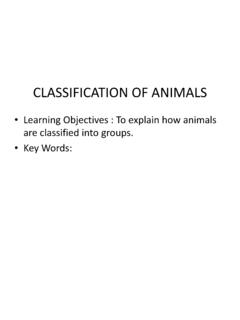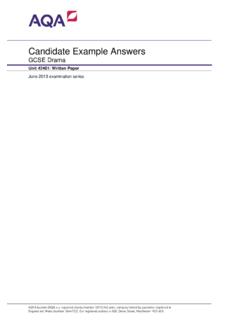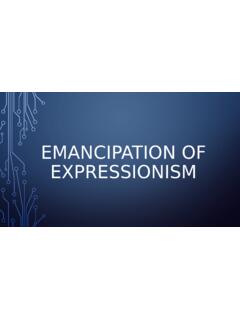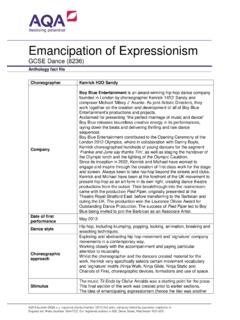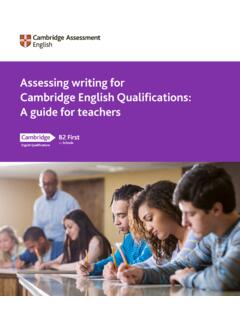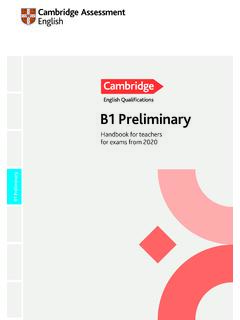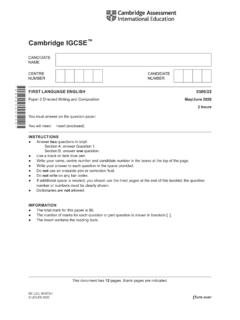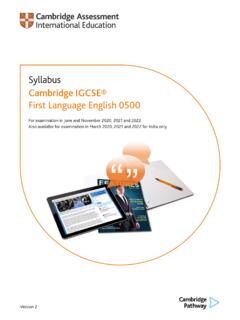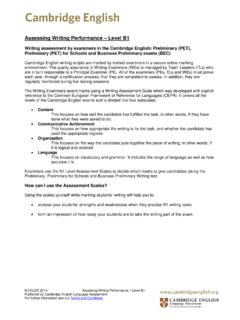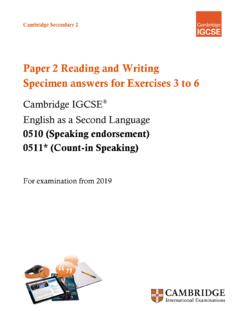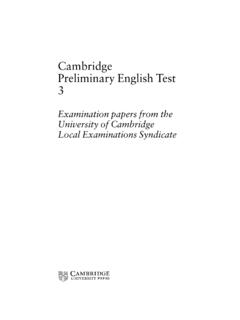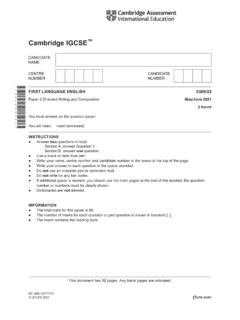Transcription of IGCSE English Language Revision Guide Paper 2
1 1 IGCSE English Language Revision Guide Paper 2 2 Contents Page Outline of the Exam Page 3 General Advice from the Examiner Page 3 Directed writing Page 4 Writer s Effect Page 7 Summary Page 10 Timings Page 13 A grade Example Paper Page 14 Past Paper Page 18 3 Outline of the Exam cambridge IGCSE English Language , Paper 2 is marked for Reading and writing skills. There are 40 marks for Reading and 10 marks for writing available, which makes a total of 50 marks. The Paper consists of 3 questions: 1. Directed writing 20 marks 2. Writer s Effect 10 marks 3. Summary 20 marks You will need to read two unseen passages. These could be non-fiction or fiction.
2 The exam lasts for 2 hours. General Advice from the Examiner: give equal attention to all sections of each question plan each question response; cross out material which is not intended to form part of the final answer explain points concisely, but in sufficient detail to convey clear meaning use your own words; do not lift whole phrases or sentences from the passages select only the material that is appropriate for the response to the question only make a point once in a response give thought to the structure and sequence of the material in the response adopt a suitable voice and register for the task, different for each question pay attention to length practice note-making, sequencing and concise expression.
3 4 Directed writing This question asks you to read a passage and then use your understanding of the passage to write a new text in a given form and for a given audience. You are marked for how many ideas you use from the text and how you develop them. 1. Read Passage A 2. Read and deconstruct the question (work out what it wants from you) CRAPF. 3. Return to Passage A and skim read for ideas to use in your response (underline or tick the details that are relevant). 4. Work out which register (voice) you will be writing in 5. Work out who you are writing to 6. Work out why you are writing the text 7. Use three different coloured highlighters (one for each bulletpoint) to highlight relevant information in the text.
4 Use this to help you plan your response. 8. Take 2 minutes to plan your response REMEMBER to write in the format asked for in the question. Use the bulletpoints to help you. Make sure you have material for each bulletpoint. 9. Write your response. 10. Spend a few minutes checking your response afterwards. Remember that you get 5 marks for writing , so your use of paragraphs, spelling, punctuation, sentences and vocabulary are all important. Top Tips: Remember to use the bulletpoints! You should write equal amounts for each bulletpoint (2-3 paragraphs for each one). Make sure that your points are relevant to the bulletpoints and that you are not just re-telling the story. Develop your ideas by explaining what the details from the passage suggest about the character/place/situation/feelings/mood etc.
5 Remember to use your own words! If you just copy the words from the passage, then the examiner cannot tell if you understand them. Content = What you have to write about it. Register= Who you have to write as. What style will be appropriate? Audience= Who you need to write for? Purpose= Why you are writing , to advise, persuade etc. Form= Type of writing , feature article, speech, interview etc. 5 Directed writing - What do the questions look like? Directed writing - Examiner s Advice: Candidates must change the Language of the passages in response to Question 1 and Question 3 in order to achieve a higher Reading and writing mark. Answer all parts of the question, giving equal attention to each of the three sections.
6 Answer in your own words and adapt material from the passage to the form and viewpoint of the response. Use all the main ideas in the passage and use detail to support them. Develop and extend some of the ideas relevantly. Create a suitable voice, tone and style for the persona in the response. 1 Julia, during her recovery, fully explained her experience to her parents. A reporter for a newspaper interviews Julia s parents and asks the following three questions only: What made you choose to visit the rainforest in Ecuador with your daughter, Julia? How did Julia s accident happen, and what did she do to survive? What are your thoughts and feelings towards the Achuar people and their way of life?
7 Write the words of the interview, beginning with the first question. Base your interview on what you have read in Passage A. Be careful to use your own words. Write between 1 and 2 sides, allowing for the size of your handwriting. Up to 15 marks are available for the content of your answer, and up to 5 marks for the quality of your writing . (20 marks) REGISTER= You need to write as both the reporter and as Julia s parents. You need to write in an appropriate style . PURPOSE= The reason why you are writing . Here it is to explain the experience CONTENT=The Answers to these three questions FORM= This tells you the type of writing , an interview AUDIENCE= This tells you that you are writing for newspaper readers, so should write in a formal style.
8 This tells you how much you should write. This means that you are mainly marked for reading. You must use details from the passage to show you have read it. You must put these details into your own words. 6 Directed writing - Mark scheme A: Content (Reading): 15 marks Band 1 13-15 The answer reveals a thorough reading of the passage. There is an appropriate amount of supporting detail, which is well integrated into the text, contributing to a strong sense of purpose and approach. Creates a consistent attitude for the writer . Takes on the role/character of the writer. Original ideas are consistently well related to the passage. Band 2 10-12 There is evidence of a competent reading of the passage.
9 Represents the attitude of the writer . Integrates some of the material with occasional effectiveness, and without repeating passage. There is some development, but not consistently sustained. There is some supporting detail throughout. Band 3 7-9 The passage has been read reasonably well, but there may be some weakness in assimilating material. There may be evidence of a mechanical use of the passage. There is focus on the task and satisfactory reference, but opportunities for development and interpretation are not always taken. Band 4 4-6 Some reference to the text is made without much inference or more than brief, factual development. Answers may be thin, lack originality or in places, lack focus on the text.
10 There is some evidence of general understanding of the main points of the passage. Band 5 1-3 Answers are either very general with little specific reference to the text OR lift sections of the original. Content is insubstantial and there is little realisation of the need to modify material from the passage. Band 6 0 There is little or no relevance to the question or to the passage. B: Quality of writing : Structure and Order, Style and Language : 5 marks Band 1: 5 The Language of the text has character and sounds real, possibly as the writer may write or speak. Comments are very clearly expressed and enhanced by a wide range of effective and/or interesting Language . Structural presentation is sound throughout.

